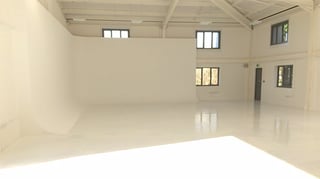When shooting small objects with a macro lens or an extension tube you can sometimes get the same effect even without the curved prop. All you need is a backdrop that matches your surface well (a white surface inside a white softbox is an obvious choice), careful lighting, and for the backdrop to be several times further away from the lens than the subject (i.e. your shiny rock should be near the front of the softbox, and the lens should be close to it — if you can't get your lens to focus close enough, it's the wrong lens.)
Because a lens focused close like this has a shallow depth of field, the backdrop and the rear part of the surface will be way out of focus, and any border between them will blur into a nice smooth gradient that doesn't attract the eye at all.
The downside of this is the usual one with macro photography: the depth of field might not be enough to cover the subject itself. A popular technique these days to deal with that is focus stacking: taking several images with slightly different focus distances and using software to combine them into a single image with the whole subject in focus. Doing that manually can be tedious, but many camera bodies have built-in support for it, so that you can click the button once and get a rapid-fire sequence of shots, each with a slightly different focus.
And it would seem that that's the technique that was used to make the image in your question: if you view the file metadata it includes the comment "Stacked from 49 images". They could have used an infinite cove, but they probably didn't have to. The 105mm focal length on a Nikon full-frame body strongly suggests that the lens used was the Nikon 105mm f/2.8G Macro.






